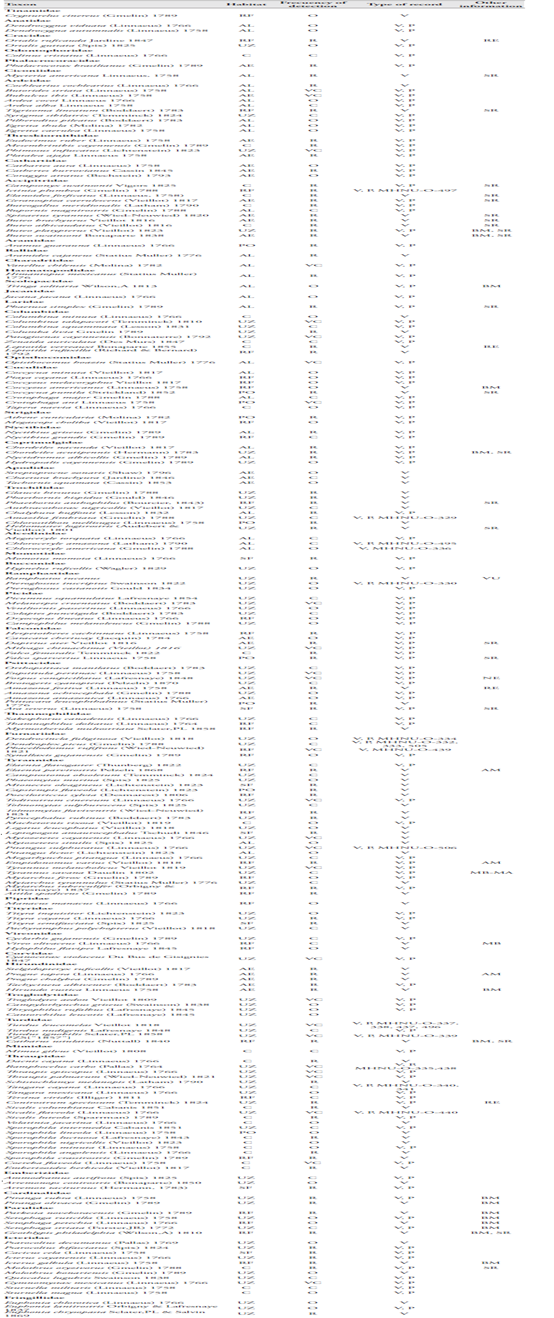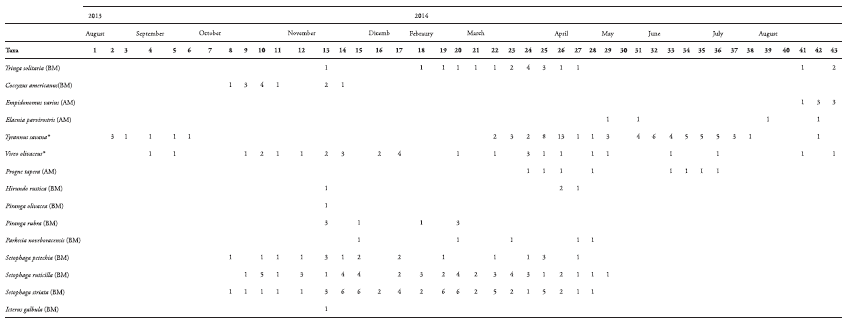INTRODUCTION
The Orinoco basin covers c. 981,000 km2 between Colombia and Venezuela, from which 343,350 km2 (35%) are found in Colombia, representing c. 30% of the country terrestrial area (LASSO et al., 2010). This region known as Eastern plains or Llanos Orientales is characterized by a great diversity of landscapes and ecosystems, which mainly involves different types of savannas (i.e. seasonally flooded, dry), as well as Andean, Amazonian, and Guianan forested habitats (RANGEL-CH., 2014). The Colombian Orinoco basin contains high levels of species diversity. To date there are records of 4347 species of vascular and 471 species of non-vascular plants, 685 fish species, 122 species of reptiles, 71 species of amphibians, 761 species of birds and 196 species of mammals (LASSO et al., 2010; ACEVEDO-CHARRY et al., 2014; MINORTA-CELY & RANGEL-CH., 2014; PARDO-MARTÍNEZ & RANGELCH., 2014; RINCÓN-E. et al., 2014; ROMERO et al., 2014; TRUJILLO-P. et al., 2014). However, despite this high biological diversity, knowledge of particular ecosystems and community dynamics is still scarce particularly due to the lack of complete or long-term inventories, which are necessary to understand the species richness and turnover of taxonomic groups across different ecosystems and subregions (LASSO et al., 2010).
Birds are one of the groups comparatively better studied in the Colombian Orinoco basin (OLIVARES, 1974; HILTY & BROWN, 1986; MCNISH, 2007; ACEVEDOCHARRY et al., 2014; ACEVEDO-CHARRY, 2017). However, the few studies conducted have traditionally focused in the Andean foothills in Meta, Casanare and Arauca departments (SALAMAN et al., 2002; ACEVEDO-CHARRY, 2017), whereas regions such as the alluvial and dissected plains of the Meta River watershed, the transition between the Orinoco and Amazon basins and the Serranía de la Macarena remains poorly studied (OLIVARES, 1962; LEMKE & GERTLER, 1978; CADENA et al., 2000; ROJAS & PIRAGUA, 2000; OCAMPO-PEÑUELA & ETTER, 2013; RESTREPO-CALLE et al., 2014). On the other hand, although some areas like the Andean foothills in the Meta department and surroundings of Villavicencio city have historically received more attention by ornithologists, most data correspond to non-systematic observations, sporadic collection of specimens and low-sampling effort studies focused on punctual localities (MEYER DE SCHAUENSEE, 1948-1952; NICÉFORO-MARÍA, 1945, 1947, 1948, 1955; SULLIVAN et al., 2009; MURILLO-PACHECO & BONILLA-ROJAS, 2016), which restrict our understanding of the species richness and composition at smaller geographical scales.
Given the complex ecosystem diversity of the Colombian Orinoco basin, coupled with the high rate of land conversion in recent decades along the Andean foothills (SÁNCHEZ-CUERVO et al., 2012), baseline data on bird communities associated to conserved and fragmented ecosystems is essential to understand local and regional patterns of species diversity, and to developing and implementing policies for conserving birds and their habitats. As an approximation of the diversity and dynamics of a bird community associated to a typical landscape of the Andean foothills-savanna transition, we present the results of a mid-term bird inventory conducted in the Barcelona campus of Universidad de los Llanos. Based on our findings, we discuss the patterns of species richness, abundance and habitat associations of the local avifauna, and document four range extensions for the Orinoco basin.
MATERIALS AND METHODS
Study site
The Barcelona campus of Universidad de los Llanos (4°04'N; 73°34'W; c. 400 m), hereon referred to as Unillanos, is located in the municipality of Villavicencio, Meta department, Colombia (Figure 1). It occupies c. 45 ha that corresponds to the foothills savanna ecosystem (JARAMILLO-J & RANGEL-CH., 2014). Original habitats such as forest, savannas and wetlands were present until the establishment of a cattle farm in 1974. Since then, habitat modification increased due to the construction of buildings and crop areas. A process of assisted vegetal succession with native trees (e.g., Jacaranda caucana, Tabebuia rosea, Hura crepitans, Caryodendron orinocense, Erythrina poepiggiana, Brownea grandiceps, Bauhinia picta, Samanea saman, Ceiba pentandra, Cariniana pyriformis, Matisia cordata, Cedrela sp., Ficus sp.) and foreign (e.g., Manguifera indica, Annona montana, Spathodea grandiflora, Bauhinia divaricate, Azadirachta indica, Averrhoa carambola) has been implemented within the campus in the last decades (L. S. Suárez & L. M. Quiñones, pers. comm.).
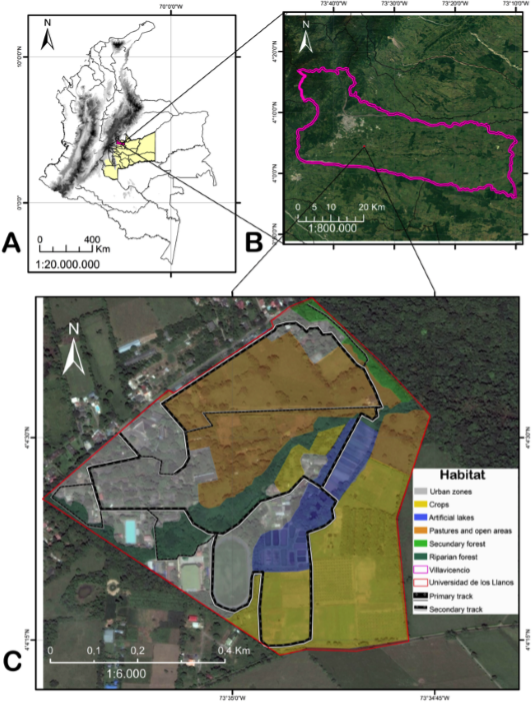
Figure 1 Map showing the geographic location of the Barcelona campus of Universidad de los Llanos, Colombia (A), and indicating its location at the transition of the foothills of Eastern Andes and savanna plains of the Orinoco basin (B). The lower inset (C) show different habitat types sampled in the campus and tracks visited during extensive observations.
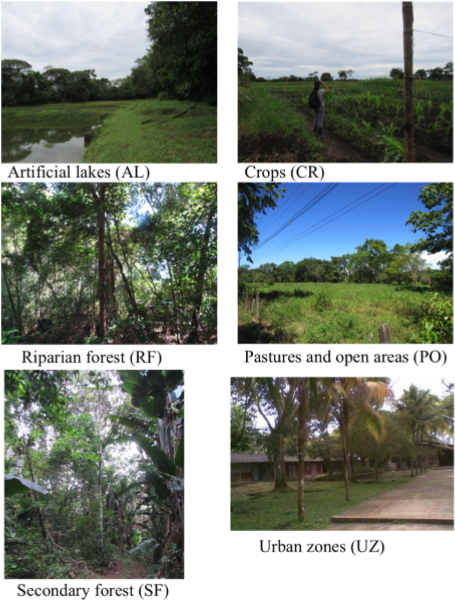
Figure 2 Types of habitats found within the Barcelona campus of Universidad de los Llanos. Photos by AMR.
Currently the area within and around the campus involves a matrix of at least six types of habitats (Figure 2): 1) artificial lakes (AL): ponds for pisciculture, surrounded by pastures, bushes and fences of trees; 2) crops (CR): mainly fruit trees (e.g. soursop, lime, plantain), and others crops like corn, cacao, bean, and pumpkin; 3) riparian forest (RF): small fragments bordering a stream that crosses the campus with trees of Ochroma pyramidale, Piptadenia flava, Cecropia sp and others Fabaceae; 4) pastures and open areas (PO): zones with pastures and fences of trees. 5) secondary forest (SF): a small area located at the north-east of the campus, connecting to a ~20 ha fragment dominated by Phenacospermun guianensis, Erythrina sp., Bauhinia sp. and other trees like Cecropia sp. and Ochroma pyramidale; and 6) urban zones (UZ): buildings and classrooms surrounded by native and foreign trees of 1-20 m height like Poeppigia procera, Erythrina poepiggiana, Bauhinia picta, Swietenia macrophylla, Ceiba pentandra, Ficus sp., among others. Humidity ranges between 47% and 75%, with an average temperature of 26°C and a unimodal annual rainfall of 4500 mm, with a rainy season from April to November (IDEAM, 2005).
Data acquisition and analysis
Between August and December 2013, and February and August 2014, we carried out 43 weekly visits to the study area. Additional observations were made opportunistically during 2013 and 2018. At least four observers walked (walking speed of c. 0.56 km/h) along a ~1.7 km transect that crosses all available habitats on the campus (Figure 1). Birds were detected and identified visually and vocally during the most active period in the mornings (06:00 to 09:00 h). For every record, we recorded species identification, number of individuals, habitat (see above) and location on the campus. Bird identification followed HILTY & BROWN (1986) and MCMULLAN et al., (2011). Avian taxonomy and lineal classification follows AVENDAÑO et al., (2017).
To determine sampling completeness, we used the non-parametric species richness estimators Chao 2 and Jacknife 2, which were calculated using EstimateS 9.10 (COLWELL, 2013). We used the accumulative frequency of detection of each species per habitat as an approximation to its abundance and habitat preferences. The frequency of detection of each species across a total of 43 visits was categorized as: very common (VC; >90% of visits), common (C; 50-90% of visits), occasional (O; 10-50% of visits), and rare (R; <10% of visits) (STOTZ et al., 1996).
We also compared the composition and diversity of the Unillanos avifauna with published inventories in the Colombian Orinoco (e.g., ROJAS & PIRAGUA, 2000; OCAMPO-PEÑUELA & ETTER 2013, ACEVEDO-CHARRY, 2017), dividing avifaunas in different categories of taxonomic and ecological groups according to STILES & BOHÓRQUEZ (2000) as follows: frugivorous-granivorous terrestrial or large (Tinamiformes, Galliformes and parrots of Ara and Amazona genera); birds of prey and scavengers (Falconiformes, Cathartiformes, Strigiformes); aquatic birds (including Alcedinidae); nectarivorous non-passerines (Trochilidae); other frugivorousgranivorous non-passerines (Columbidae, Trogonidae, Momotidae, Ramphastidae, Capitonidae), insectivorous non-passerines (Apodidae, others Piciformes, etc.); insectivorous suboscines (Furnariidae, almost all Tyrannidae); frugivorous suboscines (Cotingidae, Pipridae, Mionectes); ten-primaried-oscines, insectivorous-omnivorous (Hirundinidae to Vireonidae); nine-primaried oscines, insectivorous or omnivorous (Parulidae, Icteridae); nine-primaried oscines, frugivorous, granivorous or nectarivorous (Thraupidae, Emberizidae). Although these categories do not allow detailed specieslevel comparisons among communities (e.g. similarity analyses), this approach allowed us to determine if differences in species richness of particular bird groups within and among inventories, were the result of differences in the diversity and quality of available habitats, or to differences in the quantity and quality of sampling effort among inventories (STILES & BOHÓRQUEZ, 2000).
RESULTS
Species richness and composition
We recorded a total of 189 species through standardized sampling between 2013 and 2014. In addition, 21 species were recorded opportunistically during 2013 and 2018 for a total of 210 bird species in the campus, representing 49 families and 19 orders (Appendix 1). The families with higher number of species were Tyrannidae (28), Thraupidae (22), Icteridae (12), Ardeidae (10), Accipitridae (10), Psittacidae (9), Trochilidae (8), and Cuculidae (8); all of them accounted for 51% of total recorded species (Appendix 1). Estimated species richness ranged between 213 and 229 species according to the Chao 2 and Jacknife 2 estimators, respectively. Thus, the observed species richness ranges between 88.7% and 82.5% of the expected total avifauna for the campus. These estimates agree with the asymptotic tendency showed by the accumulation curve of observed species (Figure 3), suggesting that our inventory is representative of the local avifauna.
Excluding species recorded spontaneously, the frequencies of detection of species were not uniform (Figure 3) with most of them classified as rare (65 species; 35%) and occasional (59; 31%), followed by common (38; 20%) and very common species (27; 14%). Habitat preferences were also marked within the campus (Figure 4) with most species more frequently associated to urban zones (79; 42%). However, there were several bird species associated to riparian forests (30; 16%), artificial lakes (27; 14%), crops (22; 12%) and aerial species that overfly indistinctly different habitats (18; 9%). Secondary forest (6; 3%) and open-country species (7; 4%) were the least represented in the campus.
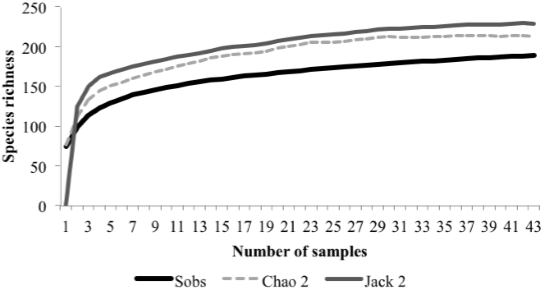
Figure 3 Species richness estimators of the avifauna from the Barcelona campus of Universidad de los Llanos. The asymptotic shape of the observed species richness curve (Sobs), compared to both species richness estimators, Chao 2 and Jack 2, suggests that the inventory is representative of the local avifauna.
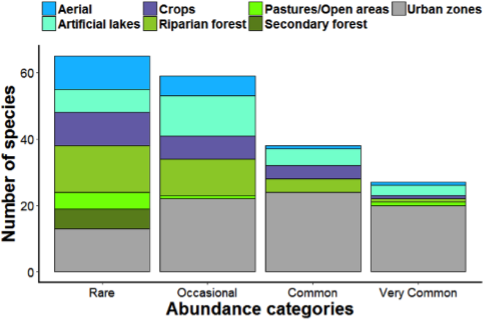
Figure 4 Frequency of detection of each species per habitat as an approximation to its abundance and habitat preferences at the Barcelona campus of Universidad de los Llanos between 2013 and 2014.
In general, 188 out of 208 bird species recorded (90.4%) were residents, whereas 15 were boreal migrants, three were austral migrants and two have both boreal and austral populations (9.6%) (Appendix 2). The migrant species recorded through standardized sampling between 2013 and 2014 showed some preliminary phenology patterns. Boreal migrants such as Yellow-billed Cuckoo (Coccyzus americanus), Yellow Warbler (Setophaga petechia), American Redstart (Setophaga ruticilla) and Blackpoll Warbler (Setophaga striata) were the first arrivals during the fall migration (October). Particularly, Solitary Sandpiper (Tringa solitaria) and most warblers were common and stayed in the area until the spring migration (April). Baltimore Oriole (Icterus galbula), Summer Tanager (Piranga rubra) and Scarlet Tanager (Piranga olivacea) were less frequent and mainly recorded later in the year (November), but Barn Swallow (Hirundo rustica) was also recorded in the spring migration (April). Fork-tailed Flycatcher (Tyrannus savana) and Red-eyed Vireo (Vireo olivaceus) were recorded during all periods of migrations possibly due to the presence of boreal and austral migrant populations. Austral migrants such as Brown-chested Martin (Progne tapera) were recorded on March, June and July. Variegated Flycatcher (Empidonomus varius) and Small-billed Elaenia (Elaenia parvirostris) were mainly recorder in May and August (Appendix 2). Finally, the list also includes one near endemic, Spectacled Parrotlet (Forpus conspicillatus) (CHAPARRO-HERRERA et al., 2013), and two species of global conservation concern, White-throated Toucan (Ramphastus tucanus) (Vulnerable) and Festive Parrot (Amazona festiva) (Near threatened) (IUCN, 2017) (Appendix 1), although these species are not threatened at national level (RENJIFO et al., 2014, 2016).
Range extensions
Rufous-vented Chachalaca, Ortalis ruficauda. Singles or pairs observed less frequently than Speckled Chachalaca O. guttata along tree fences and gallery forest inside the campus and surroundings. This species is known from the east of the Eastern Andes from Norte de Santander and Arauca (HILTY & BROWN, 1986), with recent records south to Tauramena in Casanare (XC243616). Our record represents a range extension of c. 100 km south, confirming the presence of this species for first time in the Meta department.
White-tipped Dove, Leptotila verreauxi. It occurs locally in lower numbers than Gray-fronted Dove L. rufaxilla, from which it is distinguishable by the greyish brown crown and blue-orbital skin instead of the greyish blue crown and red-orbital skin of its congener (HILTY & BROWN, 1986) (Figure 5). This species is historically known from northern Vichada (HILTY & BROWN, 1986; RESTALL et al., 2007), however, a recent number of observations and specimens along Arauca, Casanare, Meta and Vichada departments suggest a more extensive distribution in the Eastern Llanos (SULLIVAN et al., 2009; ACEVEDO-CHARRY et al., 2014).
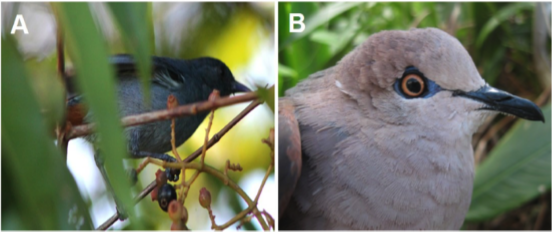
Figure 5 New bird records for the Meta department, Colombia, documented in the Barcelona campus of Los Llanos University. A: Conirostrum speciosum, B: Leptotila verreauxi.
Festive Parrot, Amazona festiva. A group of six individuals observed in April-March 2014 in the canopy of trees of the urban zone. Previously recorded in Arauca, Casanare, Vaupés and Amazonas departments (HILTY & BROWN, 1986; RODRÍGUEZ-MAHECHA & HERNÁNDEZ-CAMACHO, 2002). Our record, together with a recent sighting south of Sierra de la Macarena (SULLIVAN et al., 2009), confirm the species’ presence in Meta department.
Chestnut-vented Conebill, Conirostrum speciosum. A pair (September 2013) and a solitary male (March 2014; Figure 5) were recorded foraging in trees and bushes surrounding the urban area of the campus. Males were identified by their dull gray plumage and contrasting rufous undertail coverts. The species’ distribution in northern South America is disjunct with isolated populations in Venezuela, Guianas and Ecuador (HILTY & BROWN, 1986). In Colombia, the species has been largely known by ‘Bogotá’ specimens, however, a recent specimen was collected at the Gazaunta River watershed, municipality of Medina, Cundinamarca department (IAvH-A 10126) in the east slope of the Eastern Andes. There are several sightings along the Andean foothills and the Llanos in Meta and Casanare departments (SULLIVAN et al., 2009). These new data confirm the species’ presence along the Andean foothills and Eastern Llanos of Colombia possibly extending north to populations in Apure, Venezuela (HILTY, 2002).
DISCUSSION
Despite occupying a third part of continental Colombia and harboring 40% of the country’s bird diversity (LASSO et al., 2010; ACEVEDO-CHARRY et al., 2014), the avifauna of the Colombian Orinoco is considerably less studied than other regions in the country (AVENDAÑO et al., 2017). The only three bird inventories conducted in the region have focused mainly on primary or scarcely fragmented ecosystems (ROJAS & PIRAGUA, 2000; OCAMPO-PEÑUELA & ETTER, 2013; ACEVEDO-CHARRY, 2017). Therefore, our inventory of the Unillanos campus is instrumental in filling the knowledge gap on the regional bird species diversity, as well as contributing to understanding the effects of landscape transformation in the avifauna of ecosystems located on the Andean foothills-savanna transition.
When comparing the Unillanos avifauna with that documented for the well-preserved humid forests and savannas of Caño Limón in Arauca department (ROJAS & PIRAGUA, 2000), we found that the Unillanos campus supports a species-rich avifauna. However, the Unillanos avifauna has fewer species (210 vs. 253) and sustains a different composition of aquatic birds, birds of prey and insectivorous suboscines (Table 1), which is not surprising given that Caño Limón includes natural savannas, seasonal ponds, flood zones and large extensions of riparian forest. Similarly, although the study conducted by OCAMPO-PEÑUELA & ETTER (2013) focused mainly on birds restricted to highplain and riparian forests in San Martín de los Llanos, Meta department; there were large differences in species composition. Particularly, the Unillanos campus lacks forest interior species that are more susceptible to forest fragmentation and local extinctions such as large frugivores (e.g. Lipaugus vociferans), woodpeckers (Celeus spp) and ground insectivores (several Thamnophilids). A similar pattern is found when comparing the Unillanos campus and Tame River avifaunas (Table 1), particularly due to the presence of a high number of forest suboscines found at foothills of Tame River (e.g. Rupicola peruvianus); although the Unillanos campus stands out by the numerous aquatic birds, birds of prey, open-country insectivores and boreal migrants. The absence of several forest species at the Unillanos campus probably is in line with a generalized loss of natural ecosystems in the Apure-Villavicencio and the Llanos ecoregions as a result of agriculture and pasture expansion promoted by the Colombian government since the second half of the 19th century (LÓPEZ 1989; SÁNCHEZ-CUERVO et al., 2012). Indeed, bird collections leaded by Museo de La Salle personnel in the middle of the past century at the Villavicencio city (NICÉFORO-MARÍA 1945, 1947, 1948, 1955; HILTY & BROWN, 1986), and surrounding localities to the Unillanos campus (e.g. Ocoa River, Apiay), suggest that many species associated to mature forest, morichal, and natural savannas have been locally extirpated.
Despite the lack of forest interior and other sensitive species, the Unillanos campus harbors several forest species such as tinamous (Crypturelus cinereus), toucans (Ramphastos tucanus, Pteroglossus spp), large parrots (Amazona spp), and large insectivorous species (Nyctibius spp, Campephilus melanoleucos). This suggests that the campus maintain some level of landscape heterogeneity to serve as refuge for significant numbers of birds. Nonetheless, the large number of rare and occasional species in the campus, as well as the low representation of secondary forest species, suggests that many species are visitors or maintain reduced populations locally (MORANTE-FILHO et al., 2015; SHAW et al., 2013). This pattern has been documented in other University campuses from Colombia such as those of Universidad del Valle and Universidad del Magdalena (MUÑOZ et al., 2007; STREWE et al., 2009), which lack of fragments of mature forests and have suffered gradual processes of forest fragmentation and isolation. In this sense, given that the extension and connectivity of highplain and riparian forests in the Llanos are key attributes for maintaining regional bird diversity (OCAMPO-PEÑUELA & ETTER, 2013); the preservation of remnant vegetation patches and forest corridors around the Unillanos campus is fundamental to maintain populations of resident and visitor forest species in the region.
Table 1 Comparison of numbers of species in different taxonomic-ecological groups (see text for definitions) among the Unillanos campus, Caño Limón (ROJAS & PIRAGUA, 2000), Río Tame (ACEVEDO-CHARRY, 2017; includes only data from El Oso and Santa Librada study sites, c. 600-850 m) and San Martín de los Llanos (OCAMPO-PEÑUELA & ETTER, 2013).
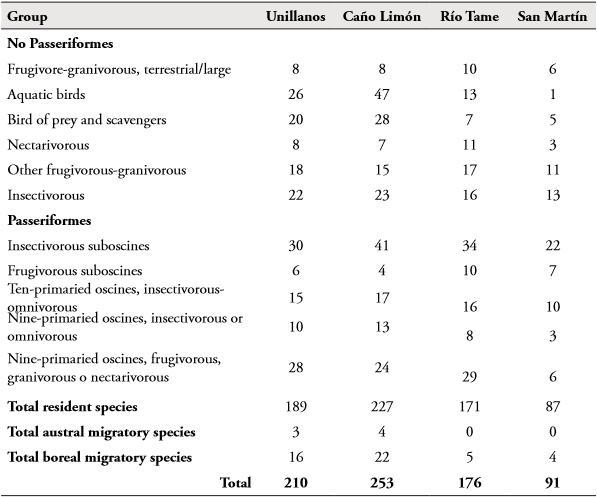
In the case of open-country species, our data suggests that the avifauna associated to urban zones is more species-rich than that found in open habitats (pastures, artificial lagoons, and aerial space), or even forest habitats. Likewise, urban-associated species tend to be more abundant (SILVA et al., 2015). Although this pattern could reflect in part a bias in sampling urban areas, these areas in the campus stand out due to their heterogeneous vegetation, which consists of native and planted trees with a tall canopy, high proliferation of epiphytes and adjacent scrubs (see Methods, Figure 2). The complex vegetation and buildings seems to offer a high concentration of resources as refuge, food, and structures to nest, which could explain why bird diversity is higher at urban zones. In this sense, urban zones at Unillanos are analogous to the wooded parks and shrubby habitats found in other University campuses, where bird diversity documented there has been higher than in other local habitats (MARÍN-GÓMEZ, 2005; MUÑOZ et al., 2007; STREWE et al., 2009).
Our study is the second in reporting data on phenology of boreal and austral migratory birds in the Colombian Orinoco (e.g. STILES, 2004). For most boreal species, periods of arrival, wintering and departure seem to agree with documented phenology patterns (HILTY & BROWN, 1986). However, these patterns were difficult to distinguish in T. savanna and V. olivaceus, which are known to have boreal, austral and resident populations in the Llanos and Amazon (STILES, 2004). On the other hand, documentation of austral migrants such as E. parvirostris, E. varius and P. tapera were more detailed during the second year of study possibly as a result of a greater emphasis on open habitats. Abundances of waders and waterfowl species are known to fluctuate in the Llanos due to seasonal migratory movements imposed by drastic droughts and floods (HILTY & BROWN, 1986; OCAMPO-PEÑUELA, 2010). Our observations suggest that some migratory movements could occur in some aquatic species (Dendrocygna spp, Jacana jacana). Moreover, temporal concentration and absence of several Sporophila seedeaters and Sicalis yellow-finches suggest possible local movements or even migratory or nomadic movements, which deserve more detailed studies at local and regional scales (HILTY, 2002).
Finally, it is worth to mention that bird community comparisons like those implemented in this study could be affected by different flaws reported by REMSEN (1994). First, although we recorded a total of 210 during our systematic sampling, we consider that only 124 species (65%) can be treated as core members of the local avifauna, namely species that breed or migrate through the campus and that were recorded in the area >10% of visits. In this sense, detailed or coarse estimates of species abundance covering uniform spans of time between seasons are key to distinguish core from no core species, which will allow us to understand what species play relevant roles in community ecology and conservation. Second, differences in quantity and quality of sampling effort could lead to misleading comparisons of species richness between habitats within a same area, as well as between different study sites. Indeed, one of the main issues that we faced when comparing species richness between Unillanos and other bird communities laid in the variety of sampling spans, and differences in the intensity of sampling techniques. These flaws could be compensated by implementing a combination of sampling techniques that emphasizes the use of sound-recordings and extensive observations, supplemented with mist-netting across different seasons. This methodology has been proposed as the most effective and efficient to conducting inventories in several Neotropical ecosystems. Particularly, by facilitating the detection of secretive or low-abundant forest species (STILES & ROSSELLI, 1998; STILES & BOHÓRQUEZ, 2000; AVENDAÑO et al., 2018). Third, the diversity of ecosystems in the Colombian Orinoco involves mosaics of habitats (e.g. morichal within savanna), which could lead to misleading comparisons of species richness among areas varying in the number of habitat types. Although community comparisons as a whole are necessary to understand patterns of species richness and turnover at a regional scale, comparing species totals by ecological and taxonomic categories allows to identify more clearly some aspects of the composition and ecological niches of the respective avifaunas (STILES & BOHÓRQUEZ, 2000). Finally, the proximity of other habitats as sources of wanderers and occasional visitors (no core species) should be taken into account when comparing species richness within and among specific natural or modified habitats. This is particularly relevant in forested habitats in the Orinoco basin, whose edges are visited by open-country species (OCAMPO-PEÑUELA & ETTER, 2013), as well in crops or savannas that are visited by forest species (TAMARIZ-TURIZO et al., 2017). Given the urgent need of conducting rapid inventories and mid-term studies on the dynamics of bird communities from the Colombian Orinoco, we urge researchers to address these concerns at the time of designing future studies. Implementation of these practices will give us the opportunity to make more complete assessments of the variation in species diversity at local and regional scales, as well as to get more precise evaluations of the conservation status of many areas.
In summary, we found that the Unillanos campus harbors a rich bird community composed by resident, boreal and austral migratory species. The avifauna associated to urban and open habitats was comparatively richer in species, and these were more abundant than their forest counterparts. However, despite anthropogenic disturbances within and around the campus, we found a good proportion of species associated to riparian and secondary forests. Our mid-term monitoring of the Unillanos avifauna also allowed us to distinguish several species that are probably part of the core avifauna of the campus, from a good component of species that are wanderers and occasional visitors from adjacent areas. In this sense, the mosaic of habitats in the campus and surroundings offer the opportunity to conduct detailed studies on community ecology of natural and fragmented ecosystems. Particularly, understanding how bird diversity vary spatially, and what species or ecological groups are more susceptible to habitat degradation is relevant for developing management and conservation strategies (KATTAN et al., 2006). In the same line, our data suggest that the geographic location of the Unillanos campus and the Villavicencio region in general is strategic to understand the poorly documented migration patterns and the impact of landscape transformation in the behavior, ecology and demographics of many austral grassland birds, as well as several Nearctic species (STILES, 2004; OCAMPO-PEÑUELA, 2010; JAHN et al., 2017). These few areas of avian research are promising, and their development will not only impact our knowledge and conservation of avian communities at local and regional scales, but also will contribute to fill the knowledge gap on diversity and ecology of the largest area of grasslands in northern South America.













